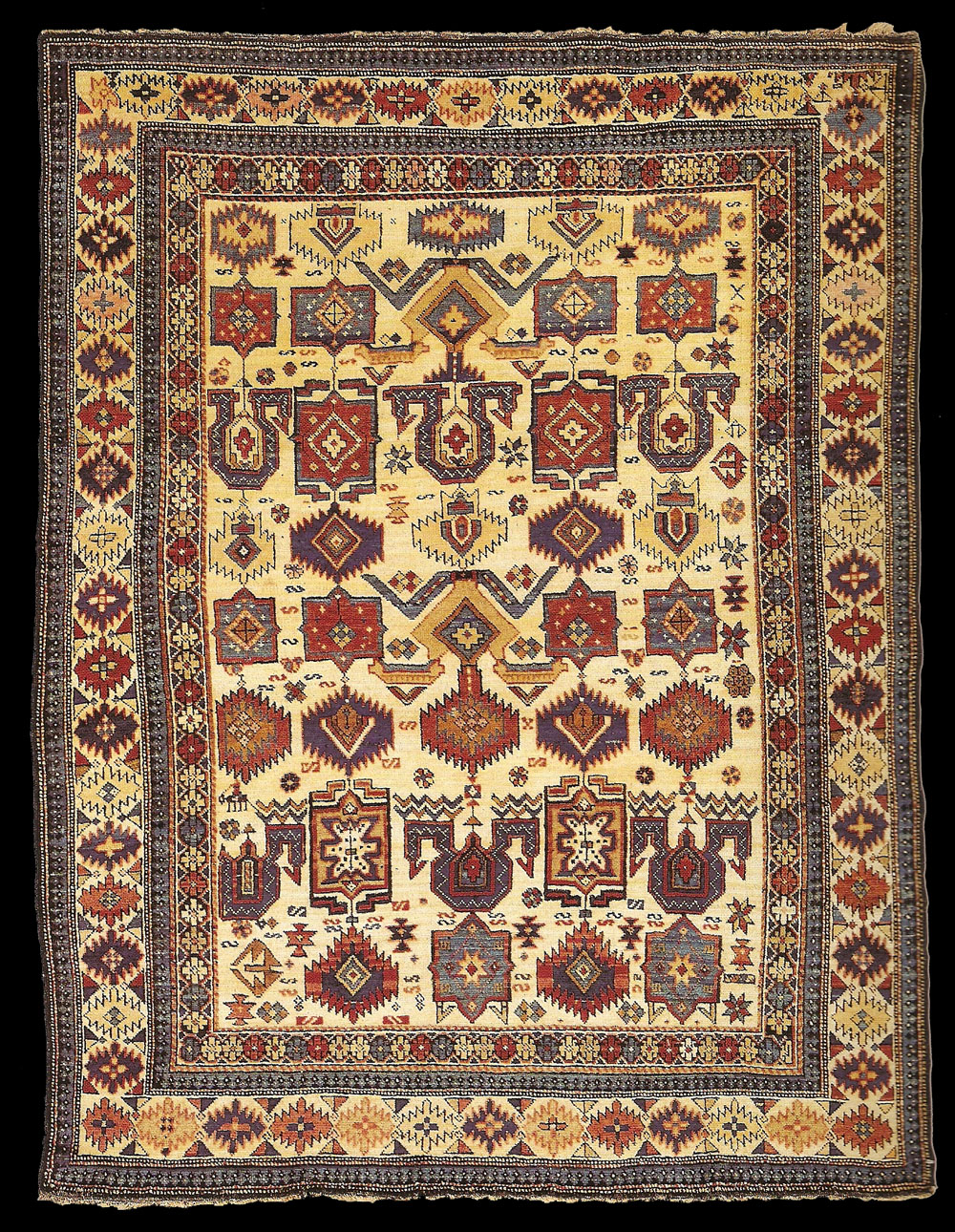|
Late 19th century
Wool pile on wool foundation
160 x 122 cm
This rare example of a Caucasian rug with an ivory background belongs to a
specific pattern typology characterized by the cloudbands that give a name
to the group since there is no definite village attribution. However, it is
certainly a rug made in the Kuba district in the northeastern Caucasus as we
can see from the ribbed back and some details of the pattern such as the
smaller frames with blue and black medacyl motifs. D. Eder who described
four in his book (Tappeti Orientali, Caucasici-Persiano. Milan, Sonzogno
1989, pp. 282-83) observed that the ashik motif of diamonds with stepped
contours of clearly Turkmen origin abound in these rugs. This 1 detail would
show that these rugs could have been made by weavers of central Asian
descent. The ashik motifs are also present in the border of our rug and in
two of those described by Eder, one of which (n.321) also has an identical
system of smaller frames with exactly the same ornaments. In the field,
however, alongside of these motifs and the more or less stylized cloud bands
we have quadrangular star shapes and other minor filler ornaments that are
quite typical of Kuba textiles, such as eight-pointed stars. "S" shapes,
eight-petal flowers, rosettes, etc. One unusual detail that, to our
knowledge, has not been seen any other rug, is the double, wavy yellow and
blue lines beneath the first row of cloud bands that could be an allusion to
the ever-present flowing water motif.

25
Kuba a nastri di nuvole
Caucaso Nord Orientale
Fine XIX secolo
Velio in lana su armatura in lana
160 x 122 cm.
Questo raro esemplare di tappeto caucasico a fondo avorio. appartiene ad
una specifica tipologia di disegno, caratterizzata dalla presenza di
cloudbands, nastri di nuvole, che danno il nome al gruppo, in mancanza di
una piu precisa attribuzione al villaggio di origine. Si tratta comunque
sicuramente di un tappeto prodotto nell'area di Kuba, nel Caucaso Nord
Orientale, come e dimostrato dalla struttura a rovescio nervato e da
alcuni dettagli di disegno, come, ad esempio, le cornici minori con il
motivo medacyl in nero e blu. D.Eder, che ne illustra ben quattro nel suo
libra (Tapped Orientali. CaucasiciPersiani, Milano, Sonzogno 1989,
pagg.282-83) ha osservato come in questi tappeti abbondino di motivi a
losanga dal profilo seghettato, noti come ashik, che sono di chiara
origine turcomanna. Questo dettaglio denoterebbe che questi tappeti
potrebbero essere stati realizzati da tessitrici di lontana discendenza
centroasiatica. Oltre che nel campo i motivi ashik sono presenti
soprattutto nella bordura, sia del nostro esemplare, che di due di quelli
illustrati dalla Eder, uno dei quali (n.321) presenta anche un identico
sistema di cornici minori con esattamente gli stessi ornamenti. Nel campo
invece, accanto a questi motivi ed a nastri di nuvole piu o meno
stilizzati, abbiamo delle forme stellate quadrangolari ed altri ornamenti
minori di riempimento, assai tipici delle tessiture Kuba, come stelle a
otto punte, motivi a 'S', fiorellini a otto petali, rosette, ecc. Un
particolare singolare, che non ci risulta sia stato osservato in alcun
altro esemplare e quello delle doppie linee ondulate in giallo e azzurro,
che appaiono al di sotto della prima ftla di cloudbands e che potrebbero
alludere al sempre presente motivo dell'acqua che scorre. |

